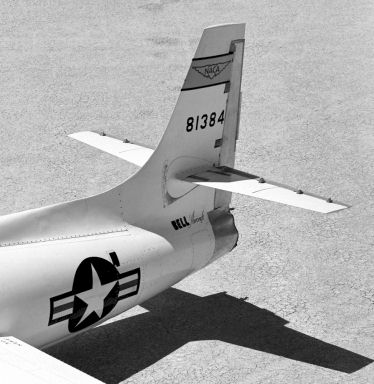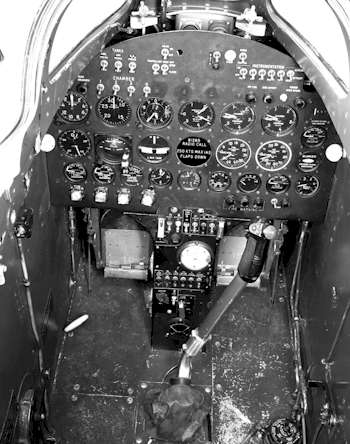by Martin Waligorski
This is the first part of the two-part feature covering the history of the Bell Aircraft Corporation X-1 series of experimental supersonic aircraft. Part two can be found here.
Background
The Bell X-1 and Chuck Yeager will always be remembered as a formidable combination.

The most famous photograph of them all, showing the X-1-1 Glamorous Glennis at altitude with the rocket engine on, displaying visible shock diamonds in the thin air. Chuck Yeager is at the controls, and the date is October 1947.
Photo: NASA
In the aeronautical industry, the problem of high speed flight was of relatively academic interest until the mid-1930s. Two technical developments of immediate pre-war years brought the area into the spotlight. The first one was the appearance of the jet engine. Although no engines suitable for practical use were yet available, the potential of jet propulsion for high speed flight was quite apparent.
The second development, the introduction of powerful, streamlined monoplane fighter, brought a series of mysterious accidents involving high speed dives. The phenomenon became known as compressibility – shock waves of compressed air causing the airframe to disintegrate. Earliest traces of such accidents go back to 1937 with the Messerschmitt Bf 109.
Eventually scientists identified the reason for the problem. The name ”sound barrier” was born – it was actually seen upon as an actual physical barrier that would have to be overcome. Equally important, the barrier was also psychological – there were many voices arguing that supersonic flight would be impossible. An interesting evidence of the doubt is that even at the time of the first supersonic flight, the Mach meter of the X-1 was still only calibrated to 1.0!
Development history
Breaking the sound barrier required solving the propulsion challenge as well as the aerodynamic challenge in a single aircraft.
The aerodynamic challenge had many grave difficulties — establishing what happens to an airplane as it accelerates through the speed of sound. As it catches up in flight with its own pressure waves, the airflow conditions around the airplane would change completely. There was a great effort in studying the phenomena of what was called transonic flight – transition between the subsonic and supersonic speed. Wind tunnel technology at that time did not offer accurate and reliable results for transonic speeds.
To research the area, the British and American governments decided to develop specialized research airplanes that would be used as flying labs – to record and take data on flow conditions at transonic speeds. In effect these airplanes were to be research tools using the sky as a laboratory. In Great Britain, the research program was managed by Miles aircraft but was dropped due to financial difficulties immediately after the war. In the United States, a program called XS-1 (Experimental Sonic One) was initiated in 1944 by USAF and NACA.

The X-1s fuselage was shaped after the 0.50 calibre machine gun bullet. For its time., it was a masterpiece of streamlining. Photo: NASA
Interestingly, both the British and the American projects arrived at the same aircraft configuration. According to the contemporary state of aeronautical science, the contours of projected aircraft were shaped after the lines of a machine gun bullet. The decision to adopt this shape allowed to utilize research on high-speed aerodynamic qualities of munitions done several years before. Besides ballistics, very little was actually known. In the absence of reliable wind tunnel data, falling back on the known and well-proven shape provided a degree of confidence.
Bell Aircraft Co. in Buffalo, NY was awarded a contract for three prototype aircraft in March 1945. Soon the ”S” was dropped from the designation of the project and the resulting aircraft was known as the X-1.
Designing the airframe
The X-1 was in principle a bullet with wings. The pattern shape was followed to the point of removing a canopy. Instead, the pilot sat behind a sloped, framed window inside a confined cockpit in the nose. To today’s onlookers, the X-1 has a markedly stubby look, but in 1947 it represented state-of-the-art in streamlining. The airframe was also very small, being only 31 feet long and had 28-foot in wingspan.
One serious consequence of the cockpit design was a completely inadequate escape provisions. The pilot entered the machine through a small hatch on the port side of the nose. There was no ejection seat, and no other emergency exit from the plane. In the bail-out situation, even if the pilot managed to climb out of the cockpit, he would be thrown behind onto the wing leading edge with fatal consequences.

Pilot’s entry to the cockpit was cumbersome to say the least, as proved by this photograph. Leaving the plane in emergency could be a nightmare, a fact sadly experienced by Joseph Cannon on X-1-3. Photo: NASA
The project team realized that the X-1 was a very dangerous airplane. After being assigned to the program, Chuck Yeager was called by Colonel Boyd who said ”You know, we’ve got a problem. I wanted a pilot who had no dependents.”. Chuck responded: ”I, yeah, I’m married and I, I’ve got a little boy, and I, I think that makes me more careful.” The explanation worked, and as we all know, Chuck Yeager was allowed to fly the aircraft.
The wing was straight (the advantages of swept-wing design for high speed aircraft hadn’t become known to the Americans before the fall of Germany. By that time, the prototype construction was well underway), but very thin, its maximum thickness being only 10% of the chord. The lesson continually learned during the X-1 was that high performance wing design should emphasize thin wings and low aspect ratios, and the thickness was eventually reduced to 4% in the X-1E.
The horizontal tail was mounted high on the fin to avoid it being affected by the turbulence from the wing. A novelty was the all-moving horizontal tail. When approaching the speed of sound, an aircraft develops a shock wave. Behind that shock wave there is a ”dead water” speed range, in which ordinary elevator control becomes extremely ineffective. The effect was already known from World War II fighters. As sufficient aerodynamic data were not available, Bell developed a precautionary backup in which the entire tail plane could be moved as an emergency measure.
The solution worked so well that it was later adopted as standard on all supersonic aircraft. It also became a well-guarded military secret, accounting in significant part for the ascendancy of F-86 Sabre over Mig-15 during the Korean conflict.
Despite its small size, the aircraft was very rugged and capable of withstanding enormous forces. The airframe was constructed from high-strength aluminium, with fuel tanks welded from steel.
Reportedly, the X-1 was a delightful airplane to fly. It had the handling characteristics of a fighter and it was very agile. None of the test pilots expressed any complaints about its flying qualities.
Inside, the fuselage was extremely crowded with the pressurized cockpit, fuel tanks, pressure tanks, undercarriage and test instrumentation.
Some airplane characteristics are:
- Fuselage length 31.0 feet
- Wing span 28.0 feet
- Horizontal tail width 11.4 feet
- Vertical tail height 8.02 feet above fuselage centerline

The fuselage of the X-1 was extremely crowded with equipment. The precise date of this photo is uncertain, but it is probably before 1948, as witnessed by the orange paint scheme. In the background there is an interesting array of early U.S. jets: Lockheed P-80 Shooting Star (two of which were used as chase planes on X-1 flights), Bell P-59 Airacomet, and a tail of the prototype Republic XP-84 Thunderjet. Photo: NASA
The propulsion challenge
A decision was made early to power the design with a rocket engine. This choice was made to shorten the development time and avoid some inevitable problems. Jet engines of the period were still in their infancy. First of all, no jet engine available had the potential of providing the thrust necessary to push the airplane into the region of the speed of sound. Secondly, there would be aerodynamic problems of providing proper airflow to the engine during the transonic flight.
The selected powerplant was the Reaction Motors XLR-11 rocket engine. Actually it was rather a set of four independent engines coupled into a single unit. The engine provided 6000 lbs of thrust. It burned liquid oxygen and a mixture of five parts alcohol to one part water. There was enough fuel for 2,5 minutes of flight with all four chambers lit.
Operating the engine was a simple affair. There was no throttle control. The pilot could just select each of the four chambers either on or off. The X-1 accelerated very, very rapidly. Pilots’ experience was ”like being hit in the back with a lead boot.”
The engine worked until it ran out of fuel. After that the pilot would glide back to the landing ground.
Test-running the engine was an unnerving experience because of the ungodly noise which caused the ground to tremble. Like with its German predecessor, the Messerschmitt Me 163, the volatile fuels were very hazardous and a constant source of concern. Because of that it was strictly forbidden to land the aircraft with remaining fuel onboard; provision was made to jettison fuel in the air.
Despite all precautions, half of X-1s produced were lost in fuel explosions.
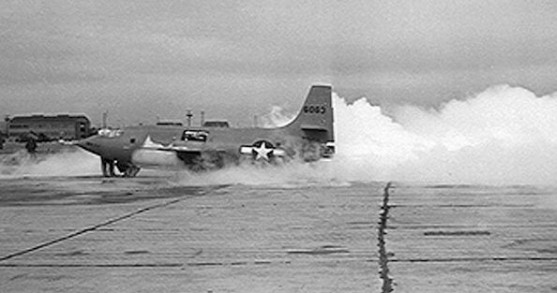
This photograph gives a good impression of the experience of the ground engine test. The aircraft is X-1-2, still in the orange paint scheme, which dates the photograph to 1947. Note the large frost patch forming on the lower fuselage in ahead of the wing. It was caused by the liquid oxygen propellant housed in the main fuel tank. Photo: NASA
The initial series
There were three X-1s built with the designations as follows: X-1-1 serial no. 46-062, X-1-2 serial no. 46-063, X-1-3 serial no. 46-064. The aircraft were flown by eighteen pilots from 1946 to 1951.
X-1-1
The original X-1-1 was the one named Glamorous Glennis by Captain Yeager in honour of his wife. Not only was this machine the first to fly faster than sound, it also achieved the only ground take-off, and reached the maximum speed of the entire program, Mach 1.45.
This aircraft was equipped with a wing of 10% thickness. It took its first unpowered flight at January 25, 1946 at Orlando, Florida. The first powered flight was made on April 11, 1946 at Muroc. The aircraft was retired in May 1950 after making 82 flights – glide and powered – with ten different pilots.
X-1-2
The X-1-2 was essentially identical to X-1-1. It was flight-tested by NACA and later modified to the X-1E configuration.
The aircraft made its first powered flight December 9, 1946, with Chalmers ”Slick” Goodlin at the controls. Until October 1951 it completed 74 glide and powered flights with nine different pilots before being rebuilt as X-1E.
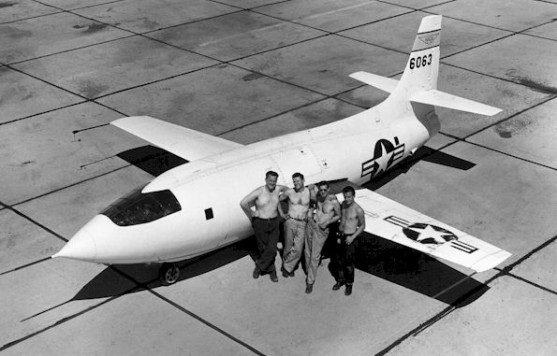
After 1948, both X-1s were repainted white. This is the X-1-2 parked on the ramp at NACA High-Speed Flight Research Station in 1949. Photo: NASA
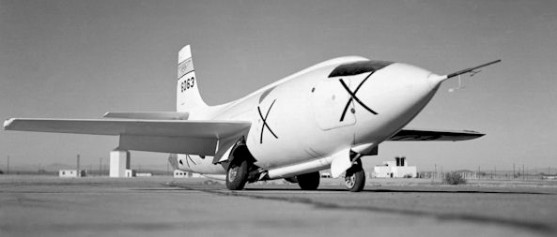
Another photo of the X-1-2 showing some extra measuring equipment on the nose probe and painted-on visual aids in form of black Xs. January 1952. Photo: NASA
X-1-3
The X-1-3 (serial 46-064) had a different fuel system with ”real” turbo-driven fuel pumps instead of a previous simplified solution using nitrogen under pressure. The system caused severe delays, and the aircraft arrived in Muroc in April 1951 – three years after the planned date. The first glide flight was made July 20, 1951. Nov. 9, 1951. The aircraft was nicknamed Queenie. Sadly, it was lost a few days later in an explosion on the ground that severely burned the pilot Joseph Cannon and wrecked the mother EB-50A.

Two photographs showing the X-1-3 during its first flight carried underneath the B-50 mother aircraft. Note the prominent cut-out for the aircraft’s fin behind the bomber’s bomb bay. Photo: NASA
X-1E
After the loss of the X-1-3 and the X-1D (see below) the decision was made to upgrade the X-1-2. The aircraft was completely rebuilt and redesignated as the X-1E.
Visible modifications included and updated canopy, new wings with only 4% thickness and knife-sharp leading edge, and a rocket assisted ejection seat.
The plane was flown 26 times until November 1956, achieving the top speed of Mach 2.24.
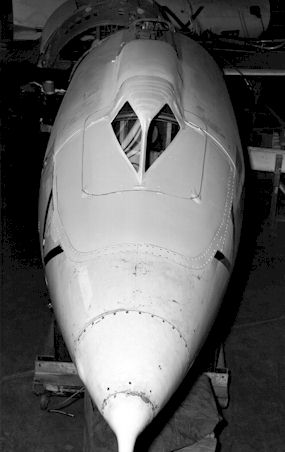
The mock-up of X-1E showing the new modified canopy. The contours of the original fuselage cutout can be still visible. Photo: NASA
The second series
After the success of the original X-1 aircraft, Bell was ordered to build a second, modified series with the capability to double the performance of the first X-1. These planes were meant to fly at speeds exceeding Mach 2. The aircraft were powered by the refined Reaction Motors XLR-11-RM-5 engine.
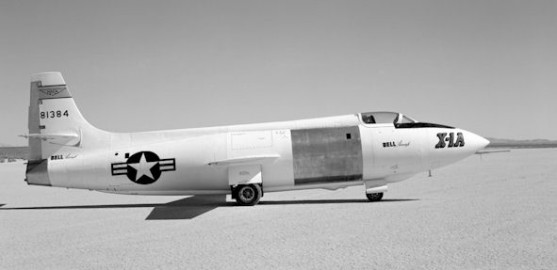
X-1A on the Rogers Dry Lakebed in 1955. The longer fuselage and revised cockpit are clearly visible. Note also the nose probe move underneath the tip of the nose. Photo: NASA

X-1A in flight in the initial natural metal livery of 1953. Note the frost stain on the fuselage. Photo: NASA
X-1A
The X-1A was first flown in on February 21, 1953. The differences from the initial X-1 included longer fuselage with increased fuel capacity, taller fin, turbo-driven fuel pumps and a clear-view cockpit canopy . The new fuselage length was 35 feet 8 inches.
The aircraft was involved in stability tests at supersonic speeds. It made a total of 15 glide and powered flights when it was destroyed following an in-flight explosion, the pilot having ejected.
X-1B
The X-1B proved the most successful of the second batch, surviving almost the entire duration of the program. It was flown 27 times starting from October 1954 and achieved a maximum speed of Mach 2.44. In 1958, cracks in the fuel tanks of the X-1B forced its grounding.
Externally, the aircraft was almost identical to the X-1A except for having a slightly different wing. For the last three flights it also carried wingtip extensions.
The aircraft was fitted with special instrumentation for exploratory aerodynamic heating tests. It had over 300 thermal probes installed on its surface. The X-1B was also
the first aircraft to fly with a system of small reaction rockets used for directional control, later used in the X-15
X-1C
The X-1C was intended to be the only armed X-1 – a test bed for weapons able to operate at supersonic speeds. It was never completed, the development being cancelled while still in the mock-up stage.
X-1D
The X-1D was to be used for further testing of heat problems in high speed flight. It was delivered, but was lost in fuel explosion during preparations for the first powered flight.
Altogether, accomplishments with the second series of aircraft were limited, mostly due to the high accident rate.
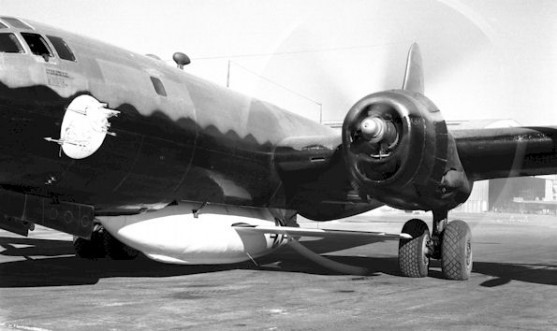
A roll-out of the Boeing B-29A mother ship with the X-1-2 mated and ready for flight. September 1949. The nose art of the B-29 depicts a stork carrying a bundle which is symbolic of the mother ship launching her ”baby”. Photo: NASA
Air launch aircraft
Though originally designed for conventional ground takeoffs, all X-1 aircraft were air-launched from a B-29 or B-50 due to the limited fuel supply and the hazard of fuel explosion during ground handling. The ground take-off was attempted only once. Having lit all four chambers, the X-1 accelerated so fast that the wing flaps blew off before the pilot was able to retract the undercarriage.
The B-29 (later B-50) was adapted as mother aircraft. The X-1 was carried aloft in its bomb bay with no pilot onboard. A modified heavy bomb shackle was used as a releasing device. At the altitude of 8000 feet, the pilot would go down the small ladder, crawl into the X-1, seal the door, plug himself into all systems (electrical, oxygen, radio) and report being ready. After that the B-29 would climb further 25000 feet before releasing the aircraft.

The X-1 is mated with the Boeing B-29. The hooks and straps used at the beginning to hold the X-1 in place in the bomb bay can be seen just above the hand of the man with the hose. Photo: NASA
Each of the X-1s had its own carrier aircraft: B-29A serial no. 45-21800 was the mother ship of X-1-1 and X-1-2. This modified Superfortress was also designated JTB-29A. The X-1-3 was carried by EB-50A serial no. 46-006.

Wouldn’t this photo make for a great diorama subject? The X-1-3 Queenie is mated to the EB-50A no. 46-006 at Muroc in November 1951. The operation was complex involving lifting the entire bomber as shown This particular X-1 only flew twice before exploding and destroying both itself and the mother aircraft. Photo: NASA
Conclusion
The most historic of all X-1 flights took place on October 14, 1947 at Muroc Air Force Base in Southern California (now known as Edwards AFB). After dropping away from the mother ship, Chuck Yeager lit off all the engine chambers and climbed on to 35000 feet. Then he turned off two of the chambers but continued climbing out to 42000 feet. Levelling the airplane he lit the 3rd chamber.
At Mach 0.96, there was a degree of buffeting and shaking, like on the previous flights. And then, when he went a little faster the Mach meter went violently off the scale. Then suddenly all the buffeting smoothed out, and the pilot realised that he had gotten above the speed of sound. Yeager let it accelerate on to about Mach 1.07, and the airplane flew quite well, even regaining some elevator control.
Having landed, Chuck Yeager called the whole experience a ”piece of cake”. A the time when the news reached the general public some seven months later, he and his colleagues would routinely break the sound barrier and fly as fast as Mach 1.45.
The greatest achievement of the X-1 program was for the first time demonstrating what we take for granted today: that with appropriate design technology it was possible for an aircraft to pass through the speed of sound – and not merely survive but be fully functional and controllable while doing so.
Glamorous Glennis resides today in the honourable spot underneath the roof of the National Air and Space Museum in Washington, DC.
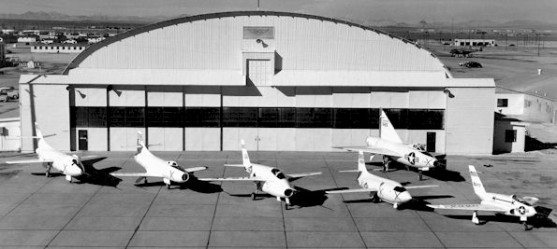
The X-1 initiated an entire series of ”X” aircraft.
Aircraft are (left to right): D-558-2, D-558-1, X-5, X-1, XF-92A, and X-4. Photo: NASA
This article was originally published in IPMS Stockholm Magazine in November 2001.

